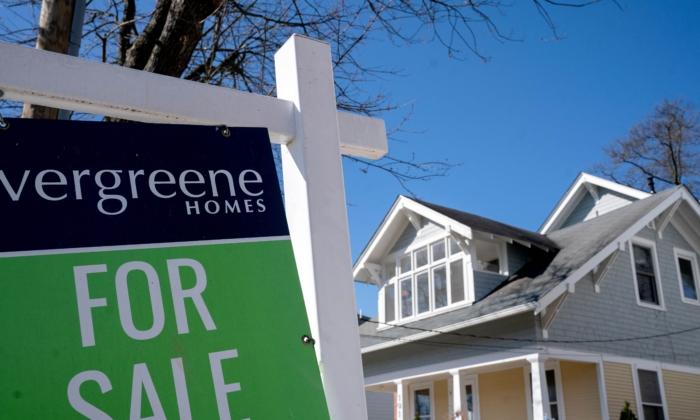U.S. mortgage rates fell from an eight-month high last week, after approaching 7 percent in the previous week, as inflation eases ahead of this week’s Federal Reserve policy meeting.
The Fed’s aggressive policy of interest rate increases sent mortgage rates well above 7 percent last year, causing the once-booming housing market to stagnate.The 30-year fixed-rate mortgage fell to 6.78 percent in the week that ended on July 20 from 6.96 percent the previous week, according to Freddie Mac on July 20. It’s the first decline since June and the biggest weekly drop since March.
The rate remains well above the year-ago average of 5.54 percent and the pre-pandemic average of 3.9 percent.
The average rate on a 15-year mortgage, which is popular among homeowners who plan to refinance, also fell to 6.06 percent, from the previous week’s 6.3 percent.“As inflation slows, mortgage rates decreased,” said Sam Khater, Freddie Mac’s chief economist.
“Still, the ongoing shortage of previously owned homes for sale has been a detriment to homebuyers looking to take advantage of declining rates.
30-Year Rates Remain High
For the past 12 months, except for one week, 30-year mortgage rates have been well above 5 percent.Rates reached their historical high of 7.08 percent in November 2022, before starting to cool off and sat below 6.5 percent for most of this spring.
Despite last month’s inflation data being generally positive, analysts are awaiting the results of the Federal Open Market Committee (FOMC) policy meeting that will conclude on July 26.
“Though inflation has slowed, the level remains well above the 2 percent target, and investors expect the Fed to hike interest rates in pursuit of this target,” Hannah Jones, an economic data analyst at Realtor.com, said last week.
“As markets prepare for next week’s FOMC meeting and the probable resulting interest rate hike, strong employment data and cooling inflation suggest that the economy’s progress toward stability is on the right track.”
Although the Fed’s rates don’t affect mortgages directly, its actions influence them, since mortgage rates tend to track the yield on 10-year U.S. Treasurys.Treasuries are affected by both anticipation of the central bank’s moves and investors’ reactions.
When yields go up or down, mortgage rates tend to follow.
Volatile Mortgage Rates Roil Housing Market
“Everyone has been spoiled by the past 15 years of low interest rates,” Dave Liniger, chairman of REMAX, told CNN.
Mr. Liniger said homebuyers may be “stuck” with these interest rates for the foreseeable future.
“We’re just going to have to learn to live with 6.5 percent or 7 percent mortgage rates for six to 18 months,” he said, dismissing certain predictions that the Fed will stop raising interest rates because of a slowdown in inflation.
However, Lawrence Yun, chief economist at the National Association of Realtors, told CNN that he predicts that mortgage rates will be closer to 6 percent by the end of the year.“This is the top,” said Mr. Yun, an optimist over the direction of mortgage rates. “It will begin to move down.”
He said he’s “fairly confident” that inflation will continue to calm because of easing rent prices, allowing the Fed to pause on rate increases after an additional increase this month.
Lisa Sturtevant, chief economist at Bright MLS, agreed, telling Fox Business that “it is not likely we will see mortgage rates below 6 percent before the end of 2023.”
“But rates should continue to come down from where they have been this summer, ” Ms. Sturtevant said.
Homebuyers Wait for Mortgage Rates to Drop Before Purchasing
Ms. Jones said buyers are waiting for rates to cool off, after mortgage rates hovered in the 6 to 7 percent range for the past 10 months. Most investors predict that such a drop will happen in the second half of this year.
“Though home prices have softened slightly nationally, the still-high cost of borrowing means hopeful homebuyers have felt little relief,” Ms. Jones said.
Even just a minor change in rates can affect how much potential homebuyers pay each month.
A May study from LendingTree compared the average monthly payments on 30-year fixed-rate mortgages in January 2022, when the rate hovered at about 3.79 percent, to April 2022, when rates rose to 5.25 percent.The report found that the increase cost borrowers hundreds of dollars more each month, which could add up to as much as $75,000 over the lifetime of the 30-year loan.
Lack of Home Inventory
Sales of existing homes have been dropping because of a shortage of available homes, which were down by 47 percent in June from pre-pandemic levels, according to Realtor.com.“Many homeowners feel ‘locked-in’ by their current mortgage rate and are therefore choosing to hold off on listing their home for sale,” Ms. Jones said.
“As a result, after more than a year of new listings lagging behind the previous year’s pace, the number of homes for sale has tracked lower than last year’s levels for the past four weeks.”
Due to limited home inventory, buyers are being forced to turn to new construction, and builders are accelerating the pace of construction to fill the gap, according to Realtor.com.“The current market dynamics are likely to persist until affordability and inventory gains are made,” Ms. Jones said.





